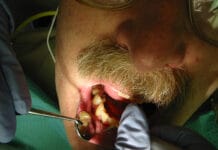Around seventy-five percent of people who have diabetes in Saudi Arabia do not take care of their sugar levels and are considered to have poor glycemic control. Several risk factors can make simple dental procedures more dangerous. Dental professionals need to be fully aware of the risks and have a protocol in place for professional and efficient patient safety.
Management Of An Emergency Tooth Extraction In Diabetic Patients On The Dental Chair by Giath Gazal determines the proper level of blood glucose a patient should have before a tooth removal as well as establish a systematic and universal approach to managing patient care in the safest possible way. So, how do you approach a tooth extraction in a diabetic patient with the correct glycemic level?
According to Gazal
According to the researcher, Giath Gazal, fewer nitric oxide is secreted into the body, which leads to poor blood circulation and decreases its clotting value, and thus the socket does not want to heal. Diabetics who cannot or do not control their glycemic levels have an increased chance of infection.
Current textbooks and medical journals available to Gazal and other dental students did not contain information about tooth extractions in diabetic patients, and the author could find no credible information on the proper glycemic levels for dental care anywhere. He, therefore, surmises that there is no definitive protocol among dentists in Saudi Arabia about the subject, which opens patients up to health issues and dental practitioners to unforeseen and ill-defined problems.
Blood Glucose Levels
Infection causes higher blood-sugar level, which, in turn, causes the body stress as it tries to kill the infectious cells. Cortisol and glucagon are released during said stress, which then releases more glucose into the bloodstream through your liver. Thus the levels rise, and healing fails.
Dehydration is common in diabetics and creates a decrease in saliva that combats candidiasis within the mouth. The decrease in saliva disrupts the pH balance in the mouth and increases the risk of acquiring candidiasis. Infections can be worse in these patients and could require medical intervention for complications and even hospital stays if the infection spreads.
Relationship Between Hyperglycemia and Infection
Diabetics had many more complications than any other non-immunocompromised individual in all aspects of the study. They have a higher chance for dental caries, various bacterial and fungal infections, and general loss of teeth through a decrease in the tooth lifespan in general, even with root canal treatment.
Periodontal disease, xerostomia, and streptococcus mutants were voracious in these patients. If these diabetic patients are elderly, then there is an increase of osteonecrosis of the jaw.
The application of PRGF, plasma-rich growth factor, to extraction sites in diabetic patients increases the healing process by accelerating the closing of the socket and increasing the growth of tissue.
Tooth Mobility and Bone Loss
Soft and hard tissues that attach the tooth to the jaw deteriorate due to a lack of blood flow caused by the increase in glucose. The poor blood circulation causes stasis in periodontal tissues. The tissue is starved of oxygen and osteoclasts form. The jaw will then be absorbed into the body, and the teeth will loosen and fall out.
Causes of Delayed Socket Healing After Tooth Extraction
Insufficient insulin levels retard the healing process, allowing more time for fungus and bacteria to find a warm and wet place to hide inside the socket. These patients are immunosuppressed. Increased insulin levels decrease nitric oxide, which directly narrows the blood vessels.
Diabetic patients are unfortunately infamous for these narrow vessels and slow healing processes. During ketoacidosis, which occurs commonly in these patients, the blood becomes acidic and not conducive to healing and fighting invaders.
Principles of Treatment For Patients With Diabetes
If a patient either declares orally or on paper that they are a diabetic, then the safest way is to always consider them immunocompromised. Antibiotic treatment should begin earlier, way before any procedures, and hypoglycemia should be avoided at all costs. Make sure that your patient is comfortable enough with you to tell you how they are feeling and ask for what they need.
Management of Dental Extraction Under Local Anesthesia
Local anesthesia and early morning appointments may lessen an individual’s stress levels and therefore decrease the risk, even just a little, for a higher blood sugar range. A patient can bring in their glucose monitor to use before any procedure, and the levels can be documented for safety.
The maximum blood glucose level that is safe for tooth extraction is 180 mg/dl. Any higher is a gamble for the practitioner and hygienists and may result in emergency procedures. Better to be safe than to be sorry.











